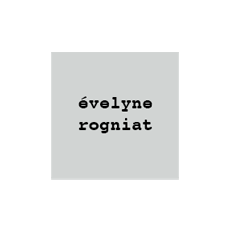
Evelyne Rogniat is passionate about literature and image - in 1969 she graduated in Classical Letters, in 1995 she obtained a doctorate in photography.
Since 1985, under the mythical shadow of a painter grandfather, she has devoted herself to photographic creation. After "Faces of Words", a book of portraits of writers, she publishes and exhibits regularly: at the National Photography Foundation (Lyon, Minsk), at the Library of Lyon (commissioned by Jean Reverzy), at the Salon de Lyon and from the South-East, at the Maison des Arts plastiques in Rhône-Alpes Auvergne, at the Orangerie du Parc with the Photographs Rencontres collective, in Arles; and on the internet with Aquarium Compagnie.
Since 2016 and the exhibition "Images Nomades" Evelyne Rogniat is represented by the Jean-Louis Mandon gallery and participates in the exhibitions of the Château de Rochebonne.
Collections
Works at the National Library of France, at the Library of Lyon, town halls of Givors, Evian, Cheyne publisher, private collections.
Publications
2018 « Rechercher Jeanne Marie », textes et photographies, préface de Satni Chaine, Jacques André éditeur.
2013 « Est-ce que cela a existé ? » 18 photographies avec texte de Chantal Ravel. Jacques André éditeur.
2010 « Lyon des Photographes » Le Bleu du Ciel/ Musée des Moulages, Lyon Editions Libel
1997 « André Kertész, le photographe à l’oeuvre » PUL-Sorbonne Nouvelle
1994 in « Jean Reverzy » : « Points de vue sur Reverzy, essai photographique d’Evelyne Rogniat », Bibliothèque Municipale de Lyon, Editions Paroles d’Aube, Lyon.
1987 « Typographie : le poème et son encre », conception Jean-François Manier, photographies Evelyne Proriol, Imprimerie de Cheyne, Le Chambon sur Lignon.
1985 « Visages des Mots, Soixante portraits d’écrivains en Rhône-Alpes », photographies d’Evelyne Proriol, textes de Jean-Marie Auzias, édition La Manufacture, Lyon.
Her photography, long devoted to black and white and drawn by herself on silver paper, now focuses more on color, often worked digitally.
She went from personal gazes on the world (China, Belarus) or people (portraits, body fragments) to a creation more focused on the fundamentals of photography: light, gaze. And from a "direct" photograph to a composite image whose layers suggest the complexity of mental images.
Thus landscapes, humans, objects dialogue in a purely imaginary space.